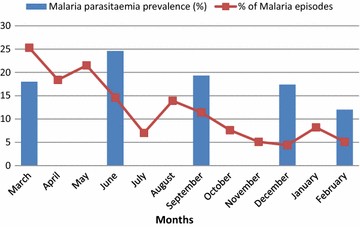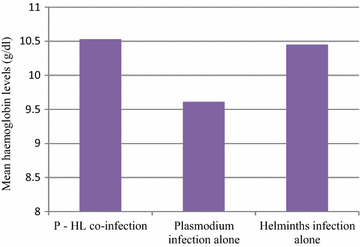Malaria, helminths, co-infection and anaemia in a cohort of children from Mutengene, south western Cameroon
- PMID: 26852392
- PMCID: PMC4744422
- DOI: 10.1186/s12936-016-1111-2
Malaria, helminths, co-infection and anaemia in a cohort of children from Mutengene, south western Cameroon
Abstract
Background: Malaria and helminthiases frequently co-infect the same individuals in endemic zones. Plasmodium falciparum and helminth infections have long been recognized as major contributors to anaemia in endemic countries. Several studies have explored the influence of helminth infections on the course of malaria in humans but how these parasites interact within co-infected individuals remains controversial.
Methods: In a community-based longitudinal study from March 2011 to February 2012, the clinical and malaria parasitaemia status of a cohort of 357 children aged 6 months to 10 years living in Mutengene, south-western region of Cameroon, was monitored. Following the determination of baseline malaria/helminths status and haemoglobin levels, the incidence of malaria and anaemia status was determined in a 12 months longitudinal study by both active and passive case detection.
Results: Among all the children who completed the study, 32.5 % (116/357) of them had at least one malaria episode. The mean (±SEM) number of malaria attacks per year was 1.44 ± 0.062 (range: 1-4 episodes) with the highest incidence of episodes occuring during the rainy season months of March-October. Children <5 years old were exposed to more malaria attacks [OR = 2.34, 95 % CI (1.15-4.75), p = 0.019] and were also more susceptible to anaemia [OR = 2.24, 95 % CI (1.85-4.23), p = 0.013] compared to older children (5-10 years old). Likewise children with malaria episodes [OR = 4.45, 95 % CI (1.66-11.94), p = 0.003] as well as those with asymptomatic parasitaemia [OR = 2.41, 95 % CI (1.58-3.69) p < 0.001] were susceptible to anaemia compared to their malaria parasitaemia negative counterparts. Considering children infected with Plasmodium alone as the reference, children infected with helminths alone were associated with protection from anaemia [OR = 0.357, 95 % CI (0.141-0.901), p = 0.029]. The mean haemoglobin level (g/dl) of participants co-infected with Plasmodium and helminths was higher (p = 0.006) compared to participants infected with Plasmodium or helminths alone.
Conclusion: Children below 5 years of age were more susceptible to malaria and anaemia. The high prevalence of anaemia in this community was largely due to malaria parasitaemia. Malaria and helminths co-infection was protective against anaemia.
Figures



Similar articles
-
Febrile status, malarial parasitaemia and gastro-intestinal helminthiases in schoolchildren resident at different altitudes, in south-western Cameroon.Ann Trop Med Parasitol. 2008 Mar;102(2):103-18. doi: 10.1179/136485908X252287. Ann Trop Med Parasitol. 2008. PMID: 18318932
-
Malaria and helminth co-infections in children living in endemic countries: A systematic review with meta-analysis.PLoS Negl Trop Dis. 2021 Feb 18;15(2):e0009138. doi: 10.1371/journal.pntd.0009138. eCollection 2021 Feb. PLoS Negl Trop Dis. 2021. PMID: 33600494 Free PMC article.
-
Malaria, helminths and malnutrition: a cross-sectional survey of school children in the South-Tongu district of Ghana.BMC Res Notes. 2016 Apr 27;9:242. doi: 10.1186/s13104-016-2025-3. BMC Res Notes. 2016. PMID: 27118136 Free PMC article.
-
Intestinal helminths as predictors of some malaria clinical outcomes and IL-1β levels in outpatients attending two public hospitals in Bamenda, North West Cameroon.PLoS Negl Trop Dis. 2021 Mar 2;15(3):e0009174. doi: 10.1371/journal.pntd.0009174. eCollection 2021 Mar. PLoS Negl Trop Dis. 2021. PMID: 33651792 Free PMC article.
-
The extent, nature, and pathogenic consequences of helminth polyparasitism in humans: A meta-analysis.PLoS Negl Trop Dis. 2019 Jun 18;13(6):e0007455. doi: 10.1371/journal.pntd.0007455. eCollection 2019 Jun. PLoS Negl Trop Dis. 2019. PMID: 31211774 Free PMC article.
Cited by
-
Red blood cell homeostasis in children and adults with and without asymptomatic malaria infection in Burkina Faso.PLoS One. 2020 Nov 30;15(11):e0242507. doi: 10.1371/journal.pone.0242507. eCollection 2020. PLoS One. 2020. PMID: 33253198 Free PMC article.
-
Malaria parasitaemia, anaemia and malnutrition in children less than 15 years residing in different altitudes along the slope of Mount Cameroon: prevalence, intensity and risk factors.Malar J. 2018 Sep 24;17(1):336. doi: 10.1186/s12936-018-2492-1. Malar J. 2018. PMID: 30249261 Free PMC article.
-
Maternal anemia is a potential risk factor for anemia in children aged 6-59 months in Southern Africa: a multilevel analysis.BMC Public Health. 2018 May 22;18(1):650. doi: 10.1186/s12889-018-5568-5. BMC Public Health. 2018. PMID: 29788935 Free PMC article.
-
Hematological indices and abnormalities among patients with uncomplicated falciparum malaria in Kosti city of the White Nile state, Sudan: a comparative study.BMC Infect Dis. 2021 May 31;21(1):507. doi: 10.1186/s12879-021-06228-y. BMC Infect Dis. 2021. PMID: 34059017 Free PMC article.
-
Asymptomatic Malaria and Helminths Coinfection and Its Association with Anemia among Primary School Children in Gedeo Zone, Southern Ethiopia: A Cross-Sectional Study.J Trop Med. 2021 Sep 13;2021:7742960. doi: 10.1155/2021/7742960. eCollection 2021. J Trop Med. 2021. PMID: 34552634 Free PMC article.
References
Publication types
MeSH terms
LinkOut - more resources
Full Text Sources
Other Literature Sources
Medical

